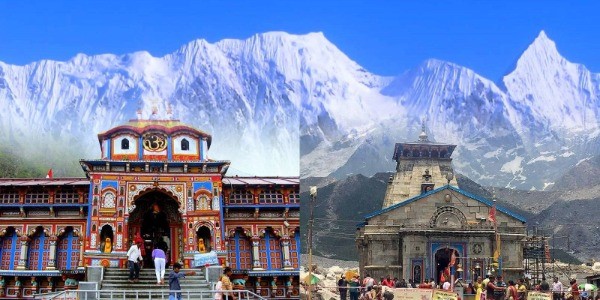 Kedarnath, one of the holiest pilgrimage sites in India, attracts thousands of devotees each year. Nestled in the Garhwal Himalayas, this sacred shrine dedicated to Lord Shiva is a dream destination for many. If you're planning a trip to Kedarnath from Mumbai, choosing the right time is crucial to ensure a smooth and fulfilling journey.Ideal Seasons for Visiting KedarnathSummer Season (May to June) - The Best TimeThe most recommended time to visit Kedarnath is during the summer months of May and June. During this period, the temple opens its doors after the harsh winter. The weather remains pleasant, with temperatures ranging between 10°C to 20°C, making it ideal for trekking and sightseeing. Pilgrims from across the country undertake the Kedarnath Yatra during these months as the routes are clear and easily accessible.Monsoon Season (July to September) - Risky Yet BeautifulThe monsoon season in Kedarnath brings heavy rainfall, often leading to landslides and road blockages. The temperatures range between 5°C to 15°C. While the lush green surroundings and mist-covered mountains create a mesmerizing landscape, traveling during this season is risky due to unpredictable weather conditions. It is advisable to check weather updates and road conditions before planning a trip in the monsoon.Autumn Season (September to October) - A Pleasant AlternativeAfter the monsoon subsides, September to October is another favorable time to visit Kedarnath. The skies are clear, the weather is cool, and the scenic beauty of the Himalayas is at its peak. Temperatures during this season range from 5°C to 18°C. Many pilgrims prefer this time as the rush reduces compared to the peak summer months, offering a more peaceful spiritual experience.Winter Season (November to April) - Not RecommendedDuring winter, Kedarnath experiences heavy snowfall, and the temple remains closed from November to April. The temperatures can drop as low as -10°C to -20°C, making it impossible to visit. However, the idol of Lord Shiva is shifted to Ukhimath, where devotees can offer their prayers.Travel Tips for Mumbaikars Visiting KedarnathBook Early: Plan your trip in advance, especially if traveling in the peak months of May and June.Layer Up: Carry warm clothing even in summer, as the temperatures drop in the evenings.Acclimatization: Since Kedarnath is at a high altitude, take a day to adjust before starting the trek.Check Weather Updates: Stay informed about weather conditions, especially if traveling during monsoon or late autumn.Stay Hydrated: The trek to Kedarnath is demanding, so keep yourself hydrated and carry energy-boosting snacks.ConclusionFor those traveling from Mumbai, the summer and autumn months are the best times to visit Kedarnath, ensuring a safe and comfortable pilgrimage. Avoid the monsoon due to landslides and winter due to extreme cold. Plan wisely, and embark on a spiritual journey to seek the blessings of Lord Shiva in the majestic Himalayan setting.Reads more : https://www.kedarnathtourpackage.com/
Kedarnath, one of the holiest pilgrimage sites in India, attracts thousands of devotees each year. Nestled in the Garhwal Himalayas, this sacred shrine dedicated to Lord Shiva is a dream destination for many. If you're planning a trip to Kedarnath from Mumbai, choosing the right time is crucial to ensure a smooth and fulfilling journey.Ideal Seasons for Visiting KedarnathSummer Season (May to June) - The Best TimeThe most recommended time to visit Kedarnath is during the summer months of May and June. During this period, the temple opens its doors after the harsh winter. The weather remains pleasant, with temperatures ranging between 10°C to 20°C, making it ideal for trekking and sightseeing. Pilgrims from across the country undertake the Kedarnath Yatra during these months as the routes are clear and easily accessible.Monsoon Season (July to September) - Risky Yet BeautifulThe monsoon season in Kedarnath brings heavy rainfall, often leading to landslides and road blockages. The temperatures range between 5°C to 15°C. While the lush green surroundings and mist-covered mountains create a mesmerizing landscape, traveling during this season is risky due to unpredictable weather conditions. It is advisable to check weather updates and road conditions before planning a trip in the monsoon.Autumn Season (September to October) - A Pleasant AlternativeAfter the monsoon subsides, September to October is another favorable time to visit Kedarnath. The skies are clear, the weather is cool, and the scenic beauty of the Himalayas is at its peak. Temperatures during this season range from 5°C to 18°C. Many pilgrims prefer this time as the rush reduces compared to the peak summer months, offering a more peaceful spiritual experience.Winter Season (November to April) - Not RecommendedDuring winter, Kedarnath experiences heavy snowfall, and the temple remains closed from November to April. The temperatures can drop as low as -10°C to -20°C, making it impossible to visit. However, the idol of Lord Shiva is shifted to Ukhimath, where devotees can offer their prayers.Travel Tips for Mumbaikars Visiting KedarnathBook Early: Plan your trip in advance, especially if traveling in the peak months of May and June.Layer Up: Carry warm clothing even in summer, as the temperatures drop in the evenings.Acclimatization: Since Kedarnath is at a high altitude, take a day to adjust before starting the trek.Check Weather Updates: Stay informed about weather conditions, especially if traveling during monsoon or late autumn.Stay Hydrated: The trek to Kedarnath is demanding, so keep yourself hydrated and carry energy-boosting snacks.ConclusionFor those traveling from Mumbai, the summer and autumn months are the best times to visit Kedarnath, ensuring a safe and comfortable pilgrimage. Avoid the monsoon due to landslides and winter due to extreme cold. Plan wisely, and embark on a spiritual journey to seek the blessings of Lord Shiva in the majestic Himalayan setting.Reads more : https://www.kedarnathtourpackage.com/  Kedarnath, one of the holiest pilgrimage sites in India, attracts thousands of devotees each year. Nestled in the Garhwal Himalayas, this sacred shrine dedicated to Lord Shiva is a dream destination for many. If you're planning a trip to Kedarnath from Mumbai, choosing the right time is crucial to ensure a smooth and fulfilling journey.Ideal Seasons for Visiting KedarnathSummer Season (May to June) - The Best TimeThe most recommended time to visit Kedarnath is during the summer months of May and June. During this period, the temple opens its doors after the harsh winter. The weather remains pleasant, with temperatures ranging between 10°C to 20°C, making it ideal for trekking and sightseeing. Pilgrims from across the country undertake the Kedarnath Yatra during these months as the routes are clear and easily accessible.Monsoon Season (July to September) - Risky Yet BeautifulThe monsoon season in Kedarnath brings heavy rainfall, often leading to landslides and road blockages. The temperatures range between 5°C to 15°C. While the lush green surroundings and mist-covered mountains create a mesmerizing landscape, traveling during this season is risky due to unpredictable weather conditions. It is advisable to check weather updates and road conditions before planning a trip in the monsoon.Autumn Season (September to October) - A Pleasant AlternativeAfter the monsoon subsides, September to October is another favorable time to visit Kedarnath. The skies are clear, the weather is cool, and the scenic beauty of the Himalayas is at its peak. Temperatures during this season range from 5°C to 18°C. Many pilgrims prefer this time as the rush reduces compared to the peak summer months, offering a more peaceful spiritual experience.Winter Season (November to April) - Not RecommendedDuring winter, Kedarnath experiences heavy snowfall, and the temple remains closed from November to April. The temperatures can drop as low as -10°C to -20°C, making it impossible to visit. However, the idol of Lord Shiva is shifted to Ukhimath, where devotees can offer their prayers.Travel Tips for Mumbaikars Visiting KedarnathBook Early: Plan your trip in advance, especially if traveling in the peak months of May and June.Layer Up: Carry warm clothing even in summer, as the temperatures drop in the evenings.Acclimatization: Since Kedarnath is at a high altitude, take a day to adjust before starting the trek.Check Weather Updates: Stay informed about weather conditions, especially if traveling during monsoon or late autumn.Stay Hydrated: The trek to Kedarnath is demanding, so keep yourself hydrated and carry energy-boosting snacks.ConclusionFor those traveling from Mumbai, the summer and autumn months are the best times to visit Kedarnath, ensuring a safe and comfortable pilgrimage. Avoid the monsoon due to landslides and winter due to extreme cold. Plan wisely, and embark on a spiritual journey to seek the blessings of Lord Shiva in the majestic Himalayan setting.Reads more : https://www.kedarnathtourpackage.com/
Kedarnath, one of the holiest pilgrimage sites in India, attracts thousands of devotees each year. Nestled in the Garhwal Himalayas, this sacred shrine dedicated to Lord Shiva is a dream destination for many. If you're planning a trip to Kedarnath from Mumbai, choosing the right time is crucial to ensure a smooth and fulfilling journey.Ideal Seasons for Visiting KedarnathSummer Season (May to June) - The Best TimeThe most recommended time to visit Kedarnath is during the summer months of May and June. During this period, the temple opens its doors after the harsh winter. The weather remains pleasant, with temperatures ranging between 10°C to 20°C, making it ideal for trekking and sightseeing. Pilgrims from across the country undertake the Kedarnath Yatra during these months as the routes are clear and easily accessible.Monsoon Season (July to September) - Risky Yet BeautifulThe monsoon season in Kedarnath brings heavy rainfall, often leading to landslides and road blockages. The temperatures range between 5°C to 15°C. While the lush green surroundings and mist-covered mountains create a mesmerizing landscape, traveling during this season is risky due to unpredictable weather conditions. It is advisable to check weather updates and road conditions before planning a trip in the monsoon.Autumn Season (September to October) - A Pleasant AlternativeAfter the monsoon subsides, September to October is another favorable time to visit Kedarnath. The skies are clear, the weather is cool, and the scenic beauty of the Himalayas is at its peak. Temperatures during this season range from 5°C to 18°C. Many pilgrims prefer this time as the rush reduces compared to the peak summer months, offering a more peaceful spiritual experience.Winter Season (November to April) - Not RecommendedDuring winter, Kedarnath experiences heavy snowfall, and the temple remains closed from November to April. The temperatures can drop as low as -10°C to -20°C, making it impossible to visit. However, the idol of Lord Shiva is shifted to Ukhimath, where devotees can offer their prayers.Travel Tips for Mumbaikars Visiting KedarnathBook Early: Plan your trip in advance, especially if traveling in the peak months of May and June.Layer Up: Carry warm clothing even in summer, as the temperatures drop in the evenings.Acclimatization: Since Kedarnath is at a high altitude, take a day to adjust before starting the trek.Check Weather Updates: Stay informed about weather conditions, especially if traveling during monsoon or late autumn.Stay Hydrated: The trek to Kedarnath is demanding, so keep yourself hydrated and carry energy-boosting snacks.ConclusionFor those traveling from Mumbai, the summer and autumn months are the best times to visit Kedarnath, ensuring a safe and comfortable pilgrimage. Avoid the monsoon due to landslides and winter due to extreme cold. Plan wisely, and embark on a spiritual journey to seek the blessings of Lord Shiva in the majestic Himalayan setting.Reads more : https://www.kedarnathtourpackage.com/ Thu, 27 March 25 : 18:03 : Kedarnath tour package
Visit / Join Group to Reply


